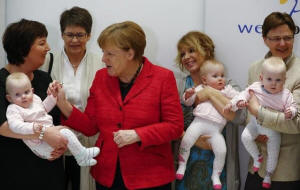|
In research
looking at how much babies around the world cry in their first
three months, psychologists from Britain have created the first
universal charts for normal amounts of crying during that
period.
"Babies are already very different in how much they cry in the
first weeks of life," said Dieter Wolker, who led the study at
Warwick University.
"We may learn more from looking at cultures where there is less
crying -- (including) whether this may be due to parenting or
other factors relating to pregnancy experiences or genetics."
The highest levels of colic – defined as crying more than three
hours a day for at least three days a week – were found in
babies in Britain, Canada and Italy, while the lowest colic
rates were found in Denmark and Germany.
On average, the study found, babies cry for around two hours a
day in the first two weeks. They then cry a little more in the
following few weeks until they peak at around two hours 15
minutes a day at six weeks. This then reduces to an average of
one hour 10 minutes by the time they are 12 weeks old.
But there are wide variations, with some babies crying as little
as 30 minutes a day, and others more than five hours.
The research, published in the Journal of Pediatrics, was a
meta-analysis of studies covering some 8,700 babies in countries
including Germany, Denmark, Japan, Canada, Italy, the
Netherlands and Britain.
Wolker said the new crying chart would help health workers
reassure parents whether their baby is crying within a normal
range in the first three months, or may need extra support.
(Reporting by Kate Kelland; Editing by Catherine Evans)
[© 2017 Thomson Reuters. All rights
reserved.] Copyright 2017 Reuters. All rights reserved. This material may not be published,
broadcast, rewritten or redistributed.
 |
|






